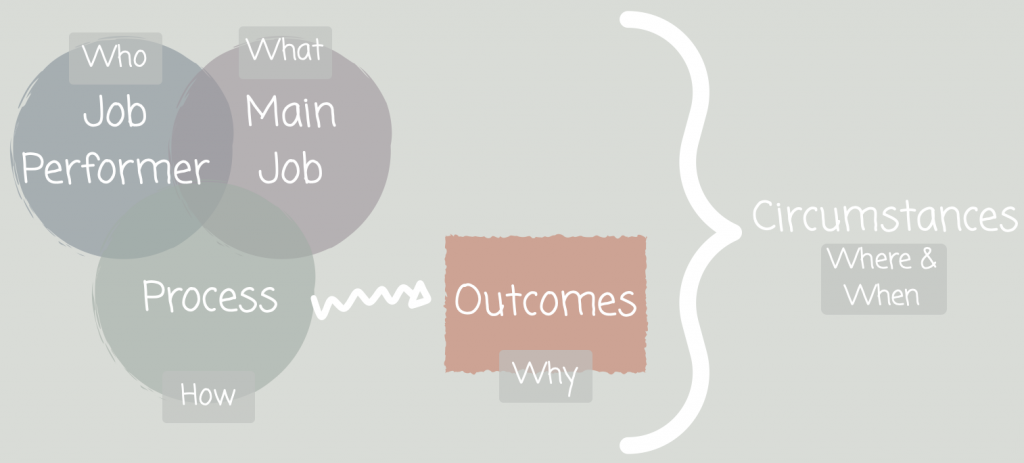What is ‘Jobs To Be Done’ – and should you apply it?
In the world of Experience Design (XD), Jobs To Be Done is becoming a popular topic. XD strategists promote it as a helpful tool to guide businesses to answer and identify their consumers’ needs. But what is Jobs To Be Done (JTBD) precisely, and how is it useful?
The theory behind JTBD
Every day you encounter a job that needs to be done. It can be big or small, from brushing your teeth in the morning or drinking your coffee, to spending an hour in a traffic jam to go to work. They are your personal JTBD. But how do JTBD play a role for your business? The answer to this question will always be linked to the famous quote of Theodore Levitt: “People do not want a quarter-inch drill, they want a quarter-inch hole”. In other words, before you look at what tool/ service you want to bring on the market, you should first look at what job the user is trying to achieve and what goal the user is looking to fulfil. (Drill refers to your solution and Hole to the wanted outcome.) This way, JTBD provides you with a framework that explains why people will use your products and services. In other words: JTBD helps you to identify your users’ needs.
How to build a JTBD?

To build a JTBD, you need five parts: job performer, main job, process, outcome and circumstances.
When defining the job performer, you look at who you want to innovate for, who will execute the job. So basically, you fill out your stakeholder’s map.
Next to the job performer one of the most crucial aspects to determine, is the main job. What is the job your user wants to complete? Take for example listening to music. First, there was a gramophone for users to do this job, next a record player, followed by radio.
The evolution of technology did not stop there because companies kept seeing new opportunities; users wanted to listen to music from everywhere, so a cassette player was developed. Cassettes were replaced by disks, so a disk player needed to be developed. As years went by, Tomislav Uzelac created the famous MP3 format, which could easily be used to store a multitude of songs on an even smaller device. This tool was then replaced by another, already existing tool and people started listening to music on their phones. This example showcases that technology evolves, but your main job stays the same, namely listening to music.
Do keep in mind that apart from this, defining a main job can be tricky as main jobs are often connected to related jobs. When looking at the previously example, listening to music is the main job, disconnecting from the world, relaxing, getting focused could be related jobs. Keeping these two apart provides a better overview.
As seen in the picture, the job performer and the main job do not only cover the objectives. There is also a process, the process of completing the main job. When defining the job process, it is essential to identify the ‘done stage’, as every process has an end. What could help when creating your job map, is to use steps and stages. The job map will outline the process of completing the job and determine where you could position your business idea (product or service).
After defining the objectives, you will look at possible outcomes. Note that it is vital to separate objectives from outcomes. Objectives are your aim, and outcomes are the way the objectives are measured. So, in other words, separating objectives and outcomes makes you look at a bigger picture. It helps you pinpoint unmet needs.
Lastly, circumstances will influence those objectives and outcomes because they help you understand the situation and the context. To define those circumstances, you will need to look at the time (when), the manner (the job) and place (where). Identifying the circumstances is a highly relevant aspect of JTB, as the context will guide you to design something that adds meaning to your user’s life.
The benefits of JTBD
Now that you are familiar with the framework, what benefits does it give a business to apply JTBD?
As said before, technology evolves, which means your users’ needs change as well. However, what they want to achieve, what job performers want as their end goal, stays the same. Without knowing the end goal, your business can keep wandering off to find new features that will not fully complete your users’ needs. Most importantly, if your business manages to identify the JTBD really well, no matter what new emerging technology is hot in the market, you will find a way to meaningfully innovate.
The JTBD framework helps businesses find where they are now, where they currently stand. It helps to uncover unmet needs and refocus on the critical aspects for the user, what they want to achieve. Refocusing on the elements that matter the most can be why users will choose your product. In other words: shift the attention from the supply side to the demand side by implementing JTBD in your company.
Does this mean businesses should implement JTBD immediately across their entire company? 1 word, 2 letters: No.
The best way is by starting small, integrating JTBD into other tools. Apart from that, the more people involved, the broader the general understanding of JTBD will be across your company and the more employees will start to talk about it.
JTBD is a helpful tool to identify unmet needs. It can help a business refocus on the essential aspects for the user and what users want to achieve.

NOTE: This blogpost is based on the theory by Jim Kalbach (https://www.linkedin.com/in/kalbach), one of the experts on Jobs To Be Done.





